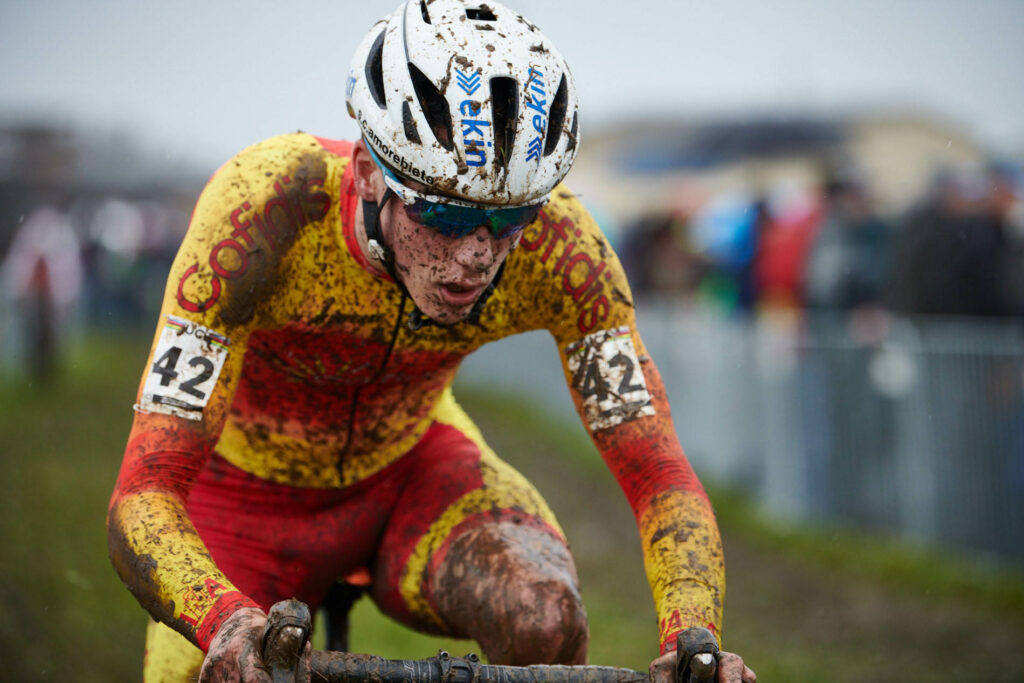How do I remove mud from cycling wear?

Six tips for successfully removing mud from cycling wear
Autumn is coming, and the rain is starting to be more frequent. Rain that has fallen on the days before the trip can make riding along muddy dirt roads more fun. But you won’t feel so happy afterwards, when the time comes to clean your bike, which is covered with mud, and your cycling wear in particular.
What cyclist has never got muddy? You don’t have to be a professional cyclist, compete in the legendary Paris-Roubaix cycling event or in a tough cyclo-cross race in some remote part of northern Europe to end up covered from head to toe in mud.

1. Don’t wait for the mud to dry
As you can see at many MTB cycling events, the organisers of the events usually provide water hoses with high pressure nozzles. That would be the ideal solution for getting rid of mud not only from your bicycle but also from your clothes, and changing into dry clothes afterwards.
However, the fact of the matter is that the mud is already dry when many cyclists arrive home. In this situation, never put your cycling jersey, bib shorts, vest and jacket in the dirty clothes bin to them clean later in the washing machine. And don’t put your outfit clothes straight into the drum of the washing machine if your cycling garments are covered with dried mud, since that could clog up the filter of your washing machine.
The ideal solution is to soak your cycling outfit in a basin, in warm water that is not over 30º. This softens the mud and makes it easier to take it off.
2. Don’t scrub the clothes with abrasive items for fabrics
When you put your cycling wear in a basin with warm water, you may be tempted to remove the dried mud more quickly by scrubbing it with a brush. Scrubbing your cycling wear briskly with a brush can destroy the internal texture of the technical fabric that provides optimal breathability for your jerseys or shorts.
If you want to scrub your clothes, always do so gently with your hands. Don’t be tempted to use your nails to scrape mud off either. Your nails can also be an abrasive item that destroys the textures in the technical fabrics of your cycling garments.

3. Always wash your cycling wear at a maximum temperature of 30 degrees
Whether you wash your cycling wear by hand or by machine, do not allow the water you use to wash it to exceed a temperature of 30º. If the water temperature is higher than this, the textures of the technical fabric of your cycling clothing may be damaged, which means that the technical fabric will stop doing its job of providing breathability, and your jersey, shorts or jacket will start to smell.
4. Always use neutral soap
It is also very important to use pH neutral soap to wash your cycling wear. Neutral laundry soap is formulated to prevent damaging the most delicate fabrics like the technical fabrics used to manufacture cycling wear.
Furthermore, as well as having a neutral pH, these types of soaps take better care of people who have more sensitive skin. Neutral soap will always make it easier for you to wash cycling wear, whether you do it by hand or in the washing machine.

5. Never use fabric softener to wash your cycling wear
Despite the instructions on the label, many cyclists have used fabric softener when washing their cycling wear in a washing machine or by hand, because they think that it smells nicer, or improves how the outfit feels when it comes into contact with their skin. The advertising campaigns of some brands of fabric softener are undoubtedly to blame for selling us these „sensations“ when advertising their product. But the truth is that softeners are the number one enemy of the technical fabrics used to make cycling wear, as they block the textures that provide breathability when we sweat.
6. Always air dry your cycling wear
Try not to dry your cycling wear in a drier if you can avoid it. The best thing for cycling wear is to air dry it. Avoid direct sunlight when temperatures are high if possible. This will preserve the colours that have been impregnated in the garments for longer using the heat stamping technique. Tumble dryers can also damage and distort the structure of technical fabrics. If you have no alternative but to use the dryer, set it at the lowest possible heat setting.
Some professional cyclists use tricks to make their jerseys or shorts dry more quickly, such as wringing the garment for as long as possible to release as much water as possible before drying.
More information about care, maintenance and washing of Inverse sportswear.







